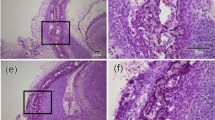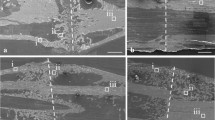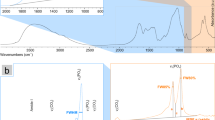Abstract
One of the most common scientific methods to study the chemical composition of bone matter is energy-dispersive X-ray spectroscopy (EDS). However, interpretation of the data obtained can be quite complicated and require a thorough understanding of bone structure. This is especially important when evaluating subtle changes of chemical composition, including the age-related ones. The aim of current study is to create a method of processing the obtained data that can be utilized in clinical medicine and use it to evaluate the age evolution of bone chemical composition. To achieve this goal, an elemental composition of 62 samples of cadaver compact bone, taken from the skull base (age: Me = 57.5; 21/91(min/max); Q1 = 39.5, Q3 = 73.75), was studied with EDS. We used the original method to estimate the amount of Mg2+ cations. We detected and confirmed an increase of Mg2+ cation formula amount in the bone apatite, which characterizes age-related resorption rate. Analysis of cation estimated ratio in a normative bone hydroxylapatite showed an increase of Mg2+ amount (R = 0.43, p = 0.0005). Also, Ca weight fraction was shown to decrease with age (R = − 0.43, p = 0.0005), which in turn confirmed the age-dependent bone decalcification. In addition, electron probe microanalysis (EPMA) and X-ray diffraction analysis (XRD) were performed. EDS data confirmed the EPMA results (R = 0.76, p = 0.001). In conclusion, the proposed method can be used in forensic medicine and provide additional data to the known trends of decalcification and change of density and crystallinity of mineral bone matter.
Graphical abstract








Similar content being viewed by others
References
Birkedal H (2017) Phase Transformations in Calcium Phosphate Crystallization. In: Van Driessche AES, Kellermeier M, Benning LG, Gebauer D (eds) New Perspectives on Mineral Nucleation and Growth: From Solution Precursors to Solid Materials. Springer International Publishing, Cham, pp 199–210
Bonicelli A, Kranioti EF, Xhemali B, Arnold E, Zioupos P (2022) Assessing bone maturity: Compositional and mechanical properties of rib cortical bone at different ages. Bone 155:116265. https://doi.org/10.1016/j.bone.2021.116265
Boskey AL, Rimnac CM, Bansal M, Federman M, Lian J, Boyan BD (1992) Effect of short-term hypomagnesemia on the chemical and mechanical properties of rat bone. J Orthop Res 10(6):774–783. https://doi.org/10.1002/jor.1100100605
Bradbury M, Sarna G (1977) Homeostasis of the ionic composition of the cerebrospinal fluid. Exp Eye Res 25:249–257. https://doi.org/10.1016/S0014-4835(77)80022-5
Burnell J, Liu C, Miller A, Teubner E (1986) Effects of dietary alteration of bicarbonate and magnesium on rat bone. Am J Physiol-Renal Physiol 250(2):F302–F307. https://doi.org/10.1152/ajprenal.1986.250.2.F302
Catherine H, Skinner W (2013) Mineralogy of bones. In: Selenius O, Alloway B, Centeno JA, Finkelman RB, Fuge R, Lindh U, Smedley P (eds) Essentials of Medical Geology. Springer, Dordrecht, pp 665–687. https://doi.org/10.1007/978-94-007-4375-5_30
Cazalbou S, Eichert D, Ranz X, Drouet C, Combes C, Harmand M, Rey C (2005) Ion exchanges in apatites for biomedical application. J Mater Sci 16(5):405–409. https://doi.org/10.1007/s10856-005-6979-2
Danilchenko S (2013) The Approach for Determination of Concentration and Location of Major Impurities (Mg, Na, K) in Biological Apatite of Mineralized Tissues. J Nano-& Electron Phys 5(3):03043–03041
De Jong W (1926) La substance minerale dans les os. Recueil des Travaux Chimiques des Pays-Bas 45:445–448. https://doi.org/10.1002/recl.19260450613
Duman E, Kehribar E, Ahan RE, Yuca E, Şeker UOS (2019) Biomineralization of Calcium Phosphate Crystals Controlled by Protein–Protein Interactions. ACS Biomater Sci Eng 5(9):4750–4763. https://doi.org/10.1021/acsbiomaterials.9b00649
Ellis KJ, Shypailo RJ, Hergenroeder A, Perez M, Abrams S (1996) Total body calcium and bone mineral content: comparison of dual-energy X-ray absorptiometry with neutron activation analysis. J Bone Miner Res 11(6):843–848. https://doi.org/10.1002/jbmr.5650110616
Endres DB (2006) Mineral and bone metabolism. Tietz textbook of clinical chemistry and molecular diagnostics, fourth. Elsevier Saunders, St. Louis
Favus MJ, Bushinsky DA, Lemann J Jr (2006) Regulation of calcium, magnesium, and phosphate metabolism. In: Rosen CJ, Bouillon R, Compston JE (eds) Primer on the metabolic bone diseases and disorders of mineral metabolism. Wiley-Blackwell, Hoboken, pp 76–83
Gaines RV, Skinner HCW, Foord EE, Mason B, Rosensweig A (1997) Dana’s new mineralogy. John Wiley & Sons, Inc., New York, Chichester, Weinheim, Brisbane, Singapore, Toronto, pp 723–732
Ghabriel MN, Vink R (2011) Magnesium transport across the blood-brain barriers. University of Adelaide Press, Adelaide
Glimcher MJ (1998) The nature of the mineral phase in bone: biological and clinical implications, metabolic bone disease and clinically related disorders. Elsevier, pp 23–52e. https://doi.org/10.1021/cr60164a001
Glimcher M (2006) Bone: nature of the calcium phosphate crystals and cellular, structural, and physical chemical mechanisms in their formation. Rev Mineral Geochem 64(1):223–282. https://doi.org/10.2138/rmg.2006.64.8
Ingervall B, Thilander B (1972) The human sphenooccipital synchondrosis I. The time of closure appraised macroscopically. Acta Odontol Scand 30(3):349–356. https://doi.org/10.3109/00016357209004602
Jahnen-Dechent W, Ketteler M (2012) Magnesium basics. Clin Kidney J 5:3–14. https://doi.org/10.1093/ndtplus/sfr163
Kranioti EF, Bonicelli A, García-Donas JG (2019) Bone-mineral density: clinical significance, methods of quantification and forensic applications. Res Rep Forensic Med Sci 9:9–21. https://doi.org/10.2147/RRFMS.S164933
Kunutsor SK, Whitehouse MR, Blom AW, Laukkanen JA (2017) Low serum magnesium levels are associated with increased risk of fractures: a long-term prospective cohort study. Eur J Epidemiol 32(7):593–603. https://doi.org/10.1007/s10654-017-0242-2
Langelier B, Wang X, Grandfield K (2017) Atomic scale chemical tomography of human bone. Sci Rep 7:39958. https://doi.org/10.1038/srep39958
Lee S, Britton W, Rowland G (1980) Magnesium toxicity: bone lesions. Poult Sci 59(11):2403–2411. https://doi.org/10.3382/ps.0592403
Legros R, Balmain N, Bonel G (1987) Age-related changes in mineral of rat and bovine cortical bone. Calcif Tissue Int 41(3):137–144. https://doi.org/10.1007/bf02563793
Maguire ME, Cowan JA (2002) Magnesium chemistry and biochemistry. Biometals 15(3):203–210. https://doi.org/10.1023/a:1016058229972
Melvin J, Glimcher (1959) Molecular biology of mineralized tissues with particular reference to bone. Rev Mod Phys 31(2):359–393. https://doi.org/10.1103/RevModPhys.31.359
Murgoci A, Duer M (2021) Molecular conformations and dynamics in the extracellular matrix of mammalian structural tissues: Solid-state NMR spectroscopy approaches. Matrix Biol Plus 12:100086. https://doi.org/10.1016/j.mbplus.2021.100086
Neuman WF, Neuman MW (1958) The chemical dynamics of bone mineral, The chemical dynamics of bone mineral. Cambridge University Press, London
Nie X (2005) Cranial base in craniofacial development: developmental features, influence on facial growth, anomaly, and molecular basis. Acta Odontol Scand 63(3):127–135. https://doi.org/10.1080/00016350510019847
Poralan GM, Gambe JE, Alcantara EM, Vequizo RM (2015) X-ray diffraction and infrared spectroscopy analyses on the crystallinity of engineered biological hydroxyapatite for medical application. In: IOP conference series: materials science and engineering. IOP Publishing, Bristol, vol. 79, p. 012028. https://doi.org/10.1088/1757-899x/79/1/012028
Powell TV, Brodie AG (1963) Closure of the spheno-occipital synchondrosis. Anat Rec 147(1):15–23. https://doi.org/10.1002/ar.1091470104
Querido W, Rossi AL, Farina M (2016) The effects of strontium on bone mineral: a review on current knowledge and microanalytical approaches. Micron 80:122–134. https://doi.org/10.1016/j.micron.2015.10.006
Rondanelli M, Faliva MA, Tartara A, Gasparri C, Perna S, Infantino V, Riva A, Petrangolini G, Peroni G (2021) An update on magnesium and bone health. Biometals 34:715–736. https://doi.org/10.1007/s10534-021-00305-0
Rude RK, Gruber HE (2004) Magnesium deficiency and osteoporosis: animal and human observations. J Nutr Biochem 15(12):710–716. https://doi.org/10.1016/j.jnutbio.2004.08.001
Sader MS, Lewis K, Soares GA, LeGeros RZ (2013) Simultaneous incorporation of magnesium and carbonate in apatite: effect on physico-chemical properties. Mater Res 16:779–784. https://doi.org/10.1590/S1516-14392013005000046
Shah FA (2021) Magnesium whitlockite–omnipresent in pathological mineralisation of soft tissues but not a significant inorganic constituent of bone. Acta Biomater. https://doi.org/10.1016/j.actbio.2021.02.021
Swaminathan R (2003) Magnesium metabolism and its disorders. Clin Biochem Rev 24(2):47
Vallet-Regi M, Navarrete DA (2016) Biological apatites in bone and teeth. In: Vallet-Regi M, Navarrete DA (eds) Nanoceramics in clinical use: from materials to applications royal society of chemistry, pp 1–29. https://doi.org/10.1039/9781782622550-00001
Von Euw S, Wang Y, Laurent G, Drouet C, Babonneau F, Nassif N, Azais T (2019) Bone mineral: new insights into its chemical composition. Sci Rep 9(1):8456. https://doi.org/10.1038/s41598-019-44620-6
Wallach S (1988) Availability of body magnesium during magnesium deficiency. Magnesium 7(5–6):262–270
Wallach S (1990) Effects of magnesium on skeletal metabolism. Magnes Trace Elem 9(1):1–14
Wilson JW, Werness PG, Smith LH (1985) Inhibitors of crystal growth of hydroxyapatite: a constant composition approach. J Urol 134(6):1255–1258. https://doi.org/10.1016/s0022-5347(17)47706-8
Yamanaka R, Shindo Y, Oka K (2019) Magnesium is a key player in neuronal maturation and neuropathology. Int J Mol Sci 20(14):3439. https://doi.org/10.3390/ijms20143439
Yu W, Qin M, Xu L, van Kuijk C, Meng X, Xing X, Cao J, Genant HK (1999) Normal changes in spinal bone mineral density in a Chinese population: assessment by quantitative computed tomography and dual-energy X-ray absorptiometry. Osteoporos Int 9(2):179–187. https://doi.org/10.1007/s001980050133
Funding
All authors certify that they have no affiliations with or involvement in any organization or entity with any financial interest or non-financial interest in the subject matter or materials discussed in this manuscript.
Author information
Authors and Affiliations
Corresponding author
Additional information
Publisher’s Note
Springer Nature remains neutral with regard to jurisdictional claims in published maps and institutional affiliations.
Rights and permissions
Springer Nature or its licensor holds exclusive rights to this article under a publishing agreement with the author(s) or other rightsholder(s); author self-archiving of the accepted manuscript version of this article is solely governed by the terms of such publishing agreement and applicable law.
About this article
Cite this article
Kravchik, M.V., Zolotenkova, G.V., Grusha, Y.O. et al. Age-related changes in cationic compositions of human cranial base bone apatite measured by X-ray energy dispersive spectroscopy (EDS) coupled with scanning electron microscope (SEM). Biometals 35, 1077–1094 (2022). https://doi.org/10.1007/s10534-022-00425-1
Received:
Accepted:
Published:
Issue Date:
DOI: https://doi.org/10.1007/s10534-022-00425-1




